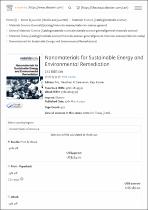JavaScript is disabled for your browser. Some features of this site may not work without it.
- ResearchSpace
- →
- Research Publications/Outputs
- →
- Books
- →
- View Item
| dc.contributor.author |
Naushad, Mu

|
|
| dc.contributor.author |
Saravanan, R

|
|
| dc.contributor.author |
Kumar, Raju

|
|
| dc.date.accessioned | 2020-07-15T10:24:59Z | |
| dc.date.available | 2020-07-15T10:24:59Z | |
| dc.date.issued | 2020-03 | |
| dc.identifier.citation | Naushad, Mu., Saravanan, R. and Kumar, R. 2020. Nanomaterials for Sustainable Energy and Environmental Remediation. 1st ed. 402pp. | en_US |
| dc.identifier.isbn | 9780128193556 | |
| dc.identifier.isbn | 9780128193563 | |
| dc.identifier.uri | https://www.elsevier.com/books/nanomaterials-for-sustainable-energy-and-environmental-remediation/naushad/978-0-12-819355-6 | |
| dc.identifier.uri | http://hdl.handle.net/10204/11477 | |
| dc.description | Copyright: 2020 Elsevier. Due to copyright restrictions, the attached pdf contains the abstract of the published item only. | en_US |
| dc.description.abstract | Nanostructured materials, especially, 1D, 2D and 3D nanostructures, and their engineered architectures are being increasingly used due to their potential to achieve sustainable development in energy and environmental sectors, providing a solution to a range of global challenges. A huge amount of research has been devoted in the recent past on the fine-tuning of nano-architecutres to accomplish innovations in energy storage and conversions, i.e., batteries, supercapacitors, fuel cells, solar cells, and electrochromic devices, bifunctional catalysts for ORR and OER, gas to fuels, liquid to fuels, and photocatalysts, corrosion, electrochemical sensors, and pollution and contaminants removal. Nanomaterials for Sustainable Energy and Environmental Remediation describes the fundamental aspects of a diverse range of nanomaterials for the sustainable development in energy and environmental remediation in a comprehensive manner. Experimental studies of varies nanomaterials will be discussed along with their design and applications, with specific attention to various chemical reactions involving and their challenges for catalysis, energy storage and conversion systems, and removal of pollutants are addressed. This book will also emphasise the challenges with past developments and direction for further research, details pertaining to the current groundbreaking technology and future perspective with multidisciplinary approach on energy, nanobiotechnology and environmental science. | en_US |
| dc.language.iso | en | en_US |
| dc.publisher | Elsevier | en_US |
| dc.relation.ispartofseries | Worklist;23419 | |
| dc.subject | Nanostructured materials | en_US |
| dc.subject | Nanobiotechnology | en_US |
| dc.title | Nanomaterials for Sustainable Energy and Environmental Remediation | en_US |
| dc.type | Book | en_US |
| dc.identifier.apacitation | Naushad, M., Saravanan, R., & Kumar, R. (2020). <i>Nanomaterials for Sustainable Energy and Environmental Remediation</i>. Elsevier. http://hdl.handle.net/10204/11477 | en_ZA |
| dc.identifier.chicagocitation | Naushad, Mu, R Saravanan, and Raju Kumar. <i>Nanomaterials for Sustainable Energy and Environmental Remediation</i>. n.p.: Elsevier. 2020. http://hdl.handle.net/10204/11477. | en_ZA |
| dc.identifier.vancouvercitation | Naushad M, Saravanan R, Kumar R. Nanomaterials for Sustainable Energy and Environmental Remediation. [place unknown]: Elsevier; 2020.http://hdl.handle.net/10204/11477 | en_ZA |
| dc.identifier.ris | TY - Book AU - Naushad, Mu AU - Saravanan, R AU - Kumar, Raju AB - Nanostructured materials, especially, 1D, 2D and 3D nanostructures, and their engineered architectures are being increasingly used due to their potential to achieve sustainable development in energy and environmental sectors, providing a solution to a range of global challenges. A huge amount of research has been devoted in the recent past on the fine-tuning of nano-architecutres to accomplish innovations in energy storage and conversions, i.e., batteries, supercapacitors, fuel cells, solar cells, and electrochromic devices, bifunctional catalysts for ORR and OER, gas to fuels, liquid to fuels, and photocatalysts, corrosion, electrochemical sensors, and pollution and contaminants removal. Nanomaterials for Sustainable Energy and Environmental Remediation describes the fundamental aspects of a diverse range of nanomaterials for the sustainable development in energy and environmental remediation in a comprehensive manner. Experimental studies of varies nanomaterials will be discussed along with their design and applications, with specific attention to various chemical reactions involving and their challenges for catalysis, energy storage and conversion systems, and removal of pollutants are addressed. This book will also emphasise the challenges with past developments and direction for further research, details pertaining to the current groundbreaking technology and future perspective with multidisciplinary approach on energy, nanobiotechnology and environmental science. DA - 2020-03 DB - ResearchSpace DP - CSIR KW - Nanostructured materials KW - Nanobiotechnology LK - https://researchspace.csir.co.za PY - 2020 SM - 9780128193556 SM - 9780128193563 T1 - Nanomaterials for Sustainable Energy and Environmental Remediation TI - Nanomaterials for Sustainable Energy and Environmental Remediation UR - http://hdl.handle.net/10204/11477 ER - | en_ZA |






